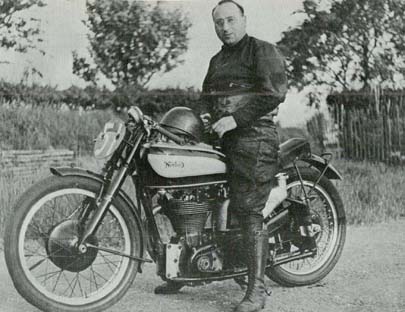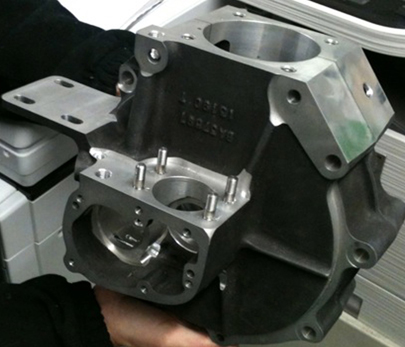Norton 1939 500cc Gardengate M30 (Manx) Build : 2020 - 2024?
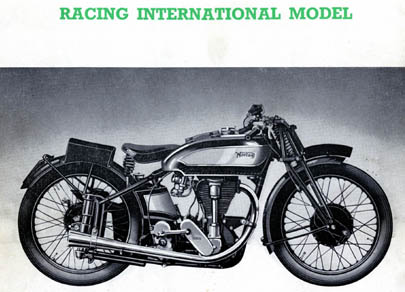
Above: Factory sales brochure picture of the 1939 M30 Racing International Model - the full SOHC racing version being described in the records as to 'Full Manx Racing Spec' - then later post war, known just as the 'Manx Norton'
Below: My project build photographed in my back office in late 2020.
At this stage the chassis had had any remedial repair work needed done and both frame and forks had been painted . But at this stage the engine (with our magnesium crankcases used) had just been loosely assembled for trial fitting - full assembly of that followed later in 2021 - which as of 2023 is now complete
.jpg)
So - this is the Summary page for a restoration/build that has been one of my 'slow burner' projects for quite a few years now. As I prepare this page in September 2023 it is still only about 70% finished - but really that is only because I have been busy with the main Norton parts business that takes the majority of my time - so as with so many other builds like this - I am not really able to commit to an end date - I will just add future articles and Youtube Links to any videos I do, as I come back to it.
And unlike other restoration projects - with this one, I have tried to cover much of it in short videos which I then post on my RacingVincent Youtube channel. So this page will put a link to each Youtube update, as well as including any additional photographs or seperate articles - so it provides a full summary.with all the links
As the title suggests - this Build/Resoration Article is for a 1939 500cc SOHC M30 (pre-War Manx) - and 1939 was the very first year that Norton offered the revised Plunger sprung frame which became known as the 'Gardengate' Frame' to the publlic.
When I first acquired the main parts for this bike many years ago - the intention was I would not start the restoration of this bike in earnest until another project had been completed - my 1948-49 600cc Sidecar Manx (which is still to do!),
but at that time I was looking for a 'Slave' chassis to test the first set of 500cc SOHC magnesium M30 crankcases we had just had cast - and it occurred to me, it would make more sense to try and 'quickly' build this bike up into a complete bike - as I was short of decent crankcases for this bike anyway, and fitting a 'slave engine' with those crankcases into my 1938 Racing International race bike - as was my original intention, would also mean lots of additional work - as it's frame was meant for aluminnium International crankcases, meaning altering the frame as well (not something I wanted to do, just to test an engine).. . and anyway, that was already a nicely sorted bike, with a recently rebuilt methanol engine and setup.
So with that backdrop - it made sense to start this build ahead of others. But as so often happens with my builds . . . back then, after the decision had been made (I guess that must have been about 2015) - lots of other things started to get in the way . . . most of them to do with paying the mortgage and keeping two jobs going - so progressing with my magnesium crankcases and building this bike has always been a lower priority project, and progress was slow..
That said - back in 2019/2020 this bike was back in the 'current project' spot - but alongside my other current project - finishing off my 1919 Douglas.
As I write this summary in September 2023 the frame and forks have now had all the difficult work done and are just waiting for me to fit new fork spindles and assemble the rear plungers. But most importantly the engine, carb and magneto are all now completed (well completed - ready for first fire-up and inevitable fettling) - and it is the main engine build that I am currently up to in my website and video updates - see below for those updates
Norton Plunger Frames - Some Background
So before going into the project itself - just a bit of background on the chassis (and I do cover the lineage of the competition SOHC engine through the 1930's in more detail, in episode 5 of the Youtube updates below):
Although I mention that 1939 was the first year the 'Gardengate' type frame was offered to the public - it was actually their 2nd iteration of a plunger frame chassis - or actually their 3rd version - strictly speaking, the 2nd version was a 'Works' only frame that was built to hold the DOHC engine that the special Works racers were using from 1938 through to 1950 - that version was never offered to the public..
The first plunger chassis type was introduced in 1936 for the then all conquering Norton Works bikes. Although most of the frame lugs and geometry were similar to the later Gardengate frame, the actual rear plunger mounts were very different - employing circular castings that held the plunger spindles and springs - rather than the later Gardengate 'inverted C' casting that held the plunger spindle at each end, with a substantial alloy slider held in place by springs on the spindle.
This earlier 'Big Plunger' type frame was used by the Works teams in 1936 and 1937, but then offered to the public in small numbers in 1937 and 1938.
At that time, the competition version of the International (M30 or pre-war Manx) was normally supplied in a Rigid frame (and SOHC models were normally built in batch's of 10) - but within that batch, the Sprung Frame bikes were identifiable by having a 'SF' added on the Works record description, to identify them from the Rigid models.
I am not sure how many of the earlier 'Big Plunger' frames were actually made - and in pre-internet days many years ago I remember being told they only made a handful for the Works team, and preferred racing customers - but actually, I found out later that they did make quite a few - and not only for the racing (Manx) M30/M40 models - but also some were in slightly different roadgoing International form, and even a few were supposedly fitted to ES2 OHV models! - although I have never seen one of these.
Looking at the Norton records many years ago, I would guess at least 30 of the earlier 'Big Plunger' framed models were produced for sale to the public, but it may have been more. As a final footnote on that earlier chassis - I remember many years ago someone telling me they thought their own bike might be 'Works' because it used this earlier frame - but the genuine Works team bikes (used only in 1936 and 1937) were identifiable from the customer bikes because their rear spring castings were liberally drilled (giving them the nickname 'Pepperpot' frames I gather) - but most importantly; because these first Works frames used the earlier 'Flat Pan' engine cradle casting - even though by that time most Norton cradle frames (rigid and plunger) had the amended bottom engine pan casting - which came up at the front.
If you want to see what a 'Big Plunger' Manx looks like then this link shows a picture of my own 1938 M30, which uses this earlier frame:
1938 Big Plunger Manx
The Gardengate Chassis - 1939-1953
So it was that in 1939 the earlier 'Big Plunger' frame was supeceded by the later 'Gardengate' plunger frame. I am not entirely sure the primary reason for the re-design - but suspect that weight played a big part, the later type plunger casting being lighter. However, I know both frame types also gained a reputation for breaking around the rear plungers - and it was common when finding old plunger Norton frames to find they had been repaired, or had had strengthening plates added around the castings - my own Big Plunger frame had been modified at some point with small gusset plates. That said - I know the Gardengate design did not entirely stop the frame breakages - I have seen quite a few examples of them being strenghened as well!
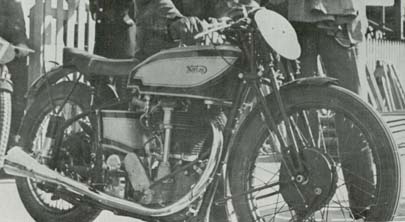
Lovely period shot of a Production Model 1939 Gardengate Manx Norton - this photo being taken at the 1939 TT, and being ridden by Harry Craine.
Click on the photo to see a larger version - which if looked at closely gives a suprising amount of detail - even the strengthening strip under the rear mudguard and the rubber covered rev clock cable (which we can offer from our RacingNorton parts catalog).
I hope my 1939 Manx build will result in looking something like this bike - arguably the prettiest Garedengate Manx model
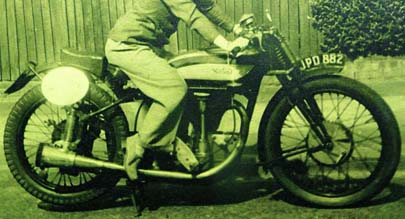
Sorry the quality of this photo is not as clear as some (and that I have cropped out the young lady that was sat on it) - but this is a lovely and rare shot of a 1939 Gardengate Manx in full race trim actually on the road in period.
Note the side of petrol tank rev clock and that it is not quite clear if it is a 'square head' or earlier 'round head' Manx motor - I think both were fitted in '39.
Note also it is fitted with a centre stand - indicating they might have included the (postwar type) centre stand lugs even in 1939.
As a final point - note wheel rims are painted black - but I gather alloy was an option in 1939 . . . I am fortunate to have a genuine '39 Manx alloy 20" alloy rim wheel to go into mine, but it will be painted black, as will the front.
This is very close to the spec I hope my finished project will follow
This 'Gardengate' frame was to be used very successfully Post-War - on Manx's up until 1951, and on road bikes a bit later than that, before being replaced by either the Featherbed chassis or the swinging arm chassis on some OHV single models. However, what differentiaated the pre-War 1939 frame from the Pos-War version - was that initially a shorter version of the rigid framed rear stand was used - but because of the different geometry of the rear plunger castings on the Gargdengate frrame - the rear stand was shortened considerablly from the rigid version, but more importantly - to make it work - the stand had to drop forward when it needed to be used as a stand, otherwise it was held up parrallel to the rear bottom frame tubes and held in place with a smalll catch.
Suicide Frame
This method of working was not unlike the rear doors of some old cars in those days - where the doors opened from the rear hinges. I well remember as a young child in the 1960's, when my parents drove an old Rover 90 with those type of doors - and accidentally opening the rear door (pre seat belt days of course) while the car was going down the road. I well remember my father in front realising what had happened and making a mad lurch over his shoulder to try and grab me before I fell out into the road, while braking at the same time!
Not suprisingly that kind of car door was sometimes coined 'suicide doors' and therefore it was no suprise that the 1939 Norton Gardengate frame was also coined the 'Suicide Frame'!
Actually, I am not sure when Norton's realised this and dispensed with that rear stand - but I suspect it was probably actually sometime in 1939 - as you can see on the period photo of the 39 Manx on the road - that looks genuine 1939, with girder forks - yet even that bike has a centre stand fitted.
I intend to fit a rear stand (which I will need to fabricate from a replica rigid rear stand I have - as I dont have the original 'Suicide' stand - I suspect most got chucked away!), but I know my frame also has the lugs for a centre stand - and these may get employed as well in use.
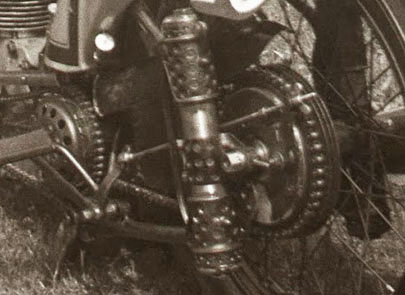
'Works' Racer Bikes - Chassis Differences To Production Bikes
Above:: This blown up photograph of the 1936-1937 Works factory bikes when they were using the 'Big Plunger type chassis shows very clearly why they got the nickname of 'Pepperpot' frames! I have seen a couple of customer bikes with similar drilling - but normaly not as comprehensive as on the factory bikes. Notice also the factory 6 spring type clutch - by this time the Works bikes were completely different to customer race bikes
Below: A lovely photograph of Harold Daniell sat on the 1938/39 type factory Works bike. Compare the chassis on this bike to the production 'Gardengate' Manx frame used in 1939 and you will see it is clearly differdent in every way. By this time the Works engines were DOHC and used magnesium crankcases which had deeper finning - necessatating bottom frame tubes whcih wrapped around the crankcases - pre-dating the later Featherbed frame design.
This frame design was never offered to the public - it was used by the Works team until the introduction of the Featherbed frame in 1950
As for the engine for this project - well I have already explained the main reason for building it - to be a slave engine to test the first set of magnesium M30 crankcases we had manufactured.
I go into more detail on the background to these first magnesium racing type crankcases from Episode 5 onwards, below (but save to say that the Works bikes first used these magnesium alloy crankcases sometime around 1933-34, and a few customer bikes started to be fitted with them from anound 1934-35. It should also be noted that up to 1948 the 350cc and 500cc crankcases were physically different in size - albeit visually very similar, and obviously - the 500cc was always more desirable to most collectors - but also (almost certainly) more highly stressed - and therefore prone to breaking. And as magnesium has a tendancy to brittle for age - it is easy to understand why few people with original 80 year old Manx pre-war crankcases would want to race them hard these days.
So with that background - I decided to build an engine to pretty much 'semi-Works' 1935-36 SOHC racing spec (as the Works team were starting to experiment with DOHC even as far back as 1936) - and in a relatively high state of engine tune - so that we could give it a proper high speed run, to ensure the crankcases were sound. However, the engine would be built to use high octane petrol, rather than petrol, as I hope to put it on the road as well when complete.
I will go into more detail on the engine build from Article 5 (below) onwards - but save to say its general spec is genuine pre-war bimetal 500cc M30 Round Head/Barrel, full magnesium M30 spec (as really only the Works engines and af few special customer bikes were), i.e. - magnesium crankcases, magnesium inner and outer timing covers, magnesium vertical bevel housings - and finally a genuine pre-war magnesium M30 cambox was to be fitted.
And finally, as I was fortunate to have in my possession a genuine Works Norton type BTH Twin Spark KH1 magneto, as used on some Works bikes in 1935-36, this was a great opportunity to try a Twin Spark setup!.
Most importantly though - as I want to test the engine hard, a new crank was made for me by Alpha's (copied exactly from another original SOHC Manx crank I supplied to them at the same time as a pattern), and a Carillo conrod and Omega forged slipper piston fitted.
All of this and other details of the build will be covered in the articles that follow . .. but save to say, the engine which as of Summer 2023 is now complete, looks both purposeful and (if I say so myself) ruggedly pretty.
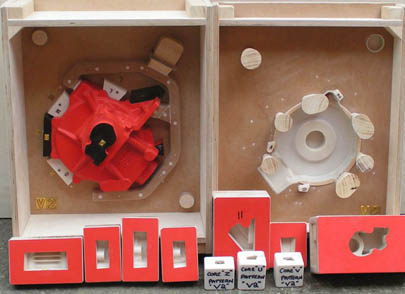
The Purpose For This Build - Testing Magnesium Crankcases
As I talk about in the text - the reason for commencing this project ahead of others about 8 years ago, was because I had undertaken the major project of re-manufaturing the original pre-War type 500cc M30 magnesium (Manx type) crankcases. Above shows the Timing Side crankcase patterns - a wonderful example of the Patternmakers art
Below: The first set of Pre-War magnesium crankcases, almost fully machined, and before they were blasted and fully re-chromated.
In the Youtube articles below (Part 5 onwards) I cover the re-creation of these crankcases in more detail, as well as a bit of history on the evolution of the different SOHC/DOHC crankcase types in that period.
As I update this listing in September 2023, the engine is now fully built around these crankcases, but the rest of the bike is not fully finished yet - but the engine went together well
When Will It Be Finished And a Running Bike?
Ideally, I am hoping that I can get the bike finished sometime in 2024, but I also know there is still a lot of work to do (I have both the correct type petrol and oil tanks - but the petrol tank needs some serous repair work), and there is a lot going on with the business that will limit the time I can spend on this project.
I would still like ultimately to make at least one small production batch of crankcases at some point in the future - and that is the main incentive to get this bike running as quickly as possible - we cannot continue until this engine is tested (and we have a second set of crankcases - to slightly different Post-War SOHC Manx spec, still being machined) . . . but frankly - getting this bike done and those tested is secondary to keeping the main parts business plates wobbling . . . so I cannot be sure.
But rest assured . . . at some point I will be putting together all the photos and short videos I have already taken, into future articles and will be updating this page as I get them published - it might just be a slow process!
Best wishes
Paul Norman
September 2023
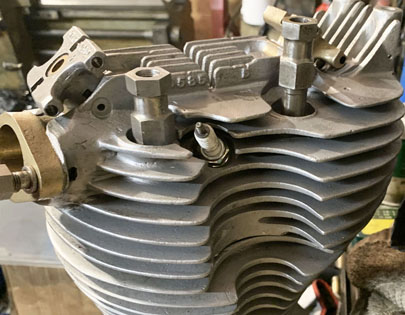
Engine Spec For This Build - Including Twin Spark Head
As well as building this pre-war M30/Manx engine wtih what are effectively brand new (and therefore - hopefully not brittle!) crankcases, I have also built it to full racing spec - including a few special features, bringing the engine to somethign approaching a SOHC semi-Works specification - I will cover more of this in the actual engine build.
However - Norton experimented briefly with Twin-Spark heads on their Works bikes in 1935 and 1936 (possibly longer?). I am fortunate to have one of those lovely genuine BTH Twin Spark magneto's - so as you can see here, that meant converting the original Bi-Metal Round Fin cylinder head to a twin spark configuration . Again, this will be covered in future articles below
Youtube: Norton M30 Update - No1
M30 Youtube Update 1
As you can see - we were deep in Lockdown when I did this first update in April 2020.
By the way - it says 'Part 3' because it I had previously done a couple of other Covid lockdown videos, not related to this project
Content:
This update covers a bit about the background to the bike build and painting/rubbing down of the the frame and fork blades
Youtube: Norton M30 Update - No2
M30 Youtube Update 2
Another Lockdown update - this one from May 2020.
Content:
This update covers work on the Gardengate rear plunger components and Manx type girder forks
Youtube: Norton M30 Update - No3
M30 Youtube Update 3
As you can see - we were deep in Lockdown when I did this first update in April 2020.
By this time - I had changed the start format of videos - and also got my numbering in line for this project - so this one was entitled 'Part 3'
Content:
This update talks about the Gardengate frame and preparing it for final painting
Youtube: Norton M30 Update - No4
M30 Youtube Update 4
Another Lockdown update - this one from May 2020.
Content:
This update covers final fitting of the headraces and starts to talk about the girder forks and the differing types of Norton girder forks pre-war
Youtube: Norton M30 Update - No5
M30 Youtube Update 5
Now moved into 2021 - and slightly different format and intro music for these updates.
Content:
This update covers assembly of the frame head races into the fram and the steering head assembly of the girder folks
Youtube: Norton M30 Update - No6. . . . Sept 2023 - Still WIP
M30 Youtube Update 6
Now we have moved to 2022 - and we start to cover the Engine build.
But - before talking about this particular engine - I give a bit about the development of the SOHC engine through the 1930's

